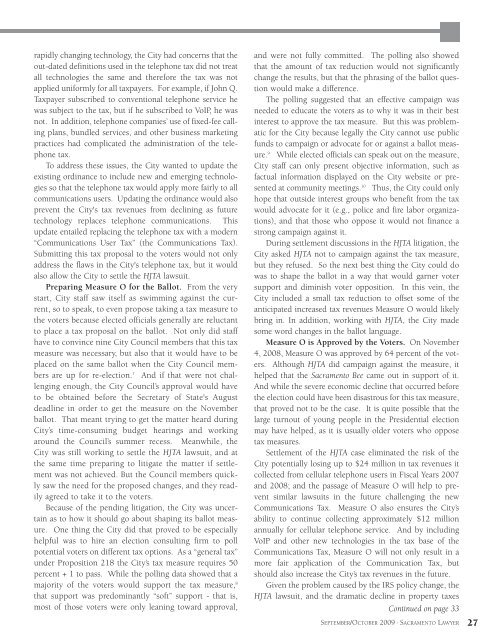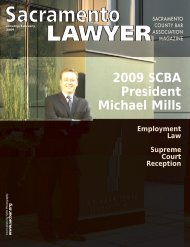September / October 2009 - Sacramento County Bar Association
September / October 2009 - Sacramento County Bar Association
September / October 2009 - Sacramento County Bar Association
You also want an ePaper? Increase the reach of your titles
YUMPU automatically turns print PDFs into web optimized ePapers that Google loves.
apidly changing technology, the City had concerns that the<br />
out-dated definitions used in the telephone tax did not treat<br />
all technologies the same and therefore the tax was not<br />
applied uniformly for all taxpayers. For example, if John Q.<br />
Taxpayer subscribed to conventional telephone service he<br />
was subject to the tax, but if he subscribed to VoIP, he was<br />
not. In addition, telephone companies’ use of fixed-fee calling<br />
plans, bundled services, and other business marketing<br />
practices had complicated the administration of the telephone<br />
tax.<br />
To address these issues, the City wanted to update the<br />
existing ordinance to include new and emerging technologies<br />
so that the telephone tax would apply more fairly to all<br />
communications users. Updating the ordinance would also<br />
prevent the City's tax revenues from declining as future<br />
technology replaces telephone communications. This<br />
update entailed replacing the telephone tax with a modern<br />
“Communications User Tax” (the Communications Tax).<br />
Submitting this tax proposal to the voters would not only<br />
address the flaws in the City's telephone tax, but it would<br />
also allow the City to settle the HJTA lawsuit.<br />
Preparing Measure O for the Ballot. From the very<br />
start, City staff saw itself as swimming against the current,<br />
so to speak, to even propose taking a tax measure to<br />
the voters because elected officials generally are reluctant<br />
to place a tax proposal on the ballot. Not only did staff<br />
have to convince nine City Council members that this tax<br />
measure was necessary, but also that it would have to be<br />
placed on the same ballot when the City Council members<br />
are up for re-election. 7 And if that were not challenging<br />
enough, the City Council’s approval would have<br />
to be obtained before the Secretary of State's August<br />
deadline in order to get the measure on the November<br />
ballot. That meant trying to get the matter heard during<br />
City’s time-consuming budget hearings and working<br />
around the Council’s summer recess. Meanwhile, the<br />
City was still working to settle the HJTA lawsuit, and at<br />
the same time preparing to litigate the matter if settlement<br />
was not achieved. But the Council members quickly<br />
saw the need for the proposed changes, and they readily<br />
agreed to take it to the voters.<br />
Because of the pending litigation, the City was uncertain<br />
as to how it should go about shaping its ballot measure.<br />
One thing the City did that proved to be especially<br />
helpful was to hire an election consulting firm to poll<br />
potential voters on different tax options. As a “general tax”<br />
under Proposition 218 the City’s tax measure requires 50<br />
percent + 1 to pass. While the polling data showed that a<br />
majority of the voters would support the tax measure, 8<br />
that support was predominantly “soft” support - that is,<br />
and were not fully committed. The polling also showed<br />
that the amount of tax reduction would not significantly<br />
change the results, but that the phrasing of the ballot question<br />
would make a difference.<br />
The polling suggested that an effective campaign was<br />
needed to educate the voters as to why it was in their best<br />
interest to approve the tax measure. But this was problematic<br />
for the City because legally the City cannot use public<br />
funds to campaign or advocate for or against a ballot measure.<br />
9 While elected officials can speak out on the measure,<br />
City staff can only present objective information, such as<br />
factual information displayed on the City website or presented<br />
at community meetings. 10 Thus, the City could only<br />
hope that outside interest groups who benefit from the tax<br />
would advocate for it (e.g., police and fire labor organizations),<br />
and that those who oppose it would not finance a<br />
strong campaign against it.<br />
During settlement discussions in the HJTA litigation, the<br />
City asked HJTA not to campaign against the tax measure,<br />
but they refused. So the next best thing the City could do<br />
was to shape the ballot in a way that would garner voter<br />
support and diminish voter opposition. In this vein, the<br />
City included a small tax reduction to offset some of the<br />
anticipated increased tax revenues Measure O would likely<br />
bring in. In addition, working with HJTA, the City made<br />
some word changes in the ballot language.<br />
Measure O is Approved by the Voters. On November<br />
4, 2008, Measure O was approved by 64 percent of the voters.<br />
Although HJTA did campaign against the measure, it<br />
helped that the <strong>Sacramento</strong> Bee came out in support of it.<br />
And while the severe economic decline that occurred before<br />
the election could have been disastrous for this tax measure,<br />
that proved not to be the case. It is quite possible that the<br />
large turnout of young people in the Presidential election<br />
may have helped, as it is usually older voters who oppose<br />
tax measures.<br />
Settlement of the HJTA case eliminated the risk of the<br />
City potentially losing up to $24 million in tax revenues it<br />
collected from cellular telephone users in Fiscal Years 2007<br />
and 2008; and the passage of Measure O will help to prevent<br />
similar lawsuits in the future challenging the new<br />
Communications Tax. Measure O also ensures the City’s<br />
ability to continue collecting approximately $12 million<br />
annually for cellular telephone service. And by including<br />
VoIP and other new technologies in the tax base of the<br />
Communications Tax, Measure O will not only result in a<br />
more fair application of the Communication Tax, but<br />
should also increase the City’s tax revenues in the future.<br />
Given the problem caused by the IRS policy change, the<br />
HJTA lawsuit, and the dramatic decline in property taxes<br />
most of those voters were only leaning toward approval, Continued on page 33<br />
SEPTEMBER/OCTOBER <strong>2009</strong> SACRAMENTO LAWYER<br />
27






